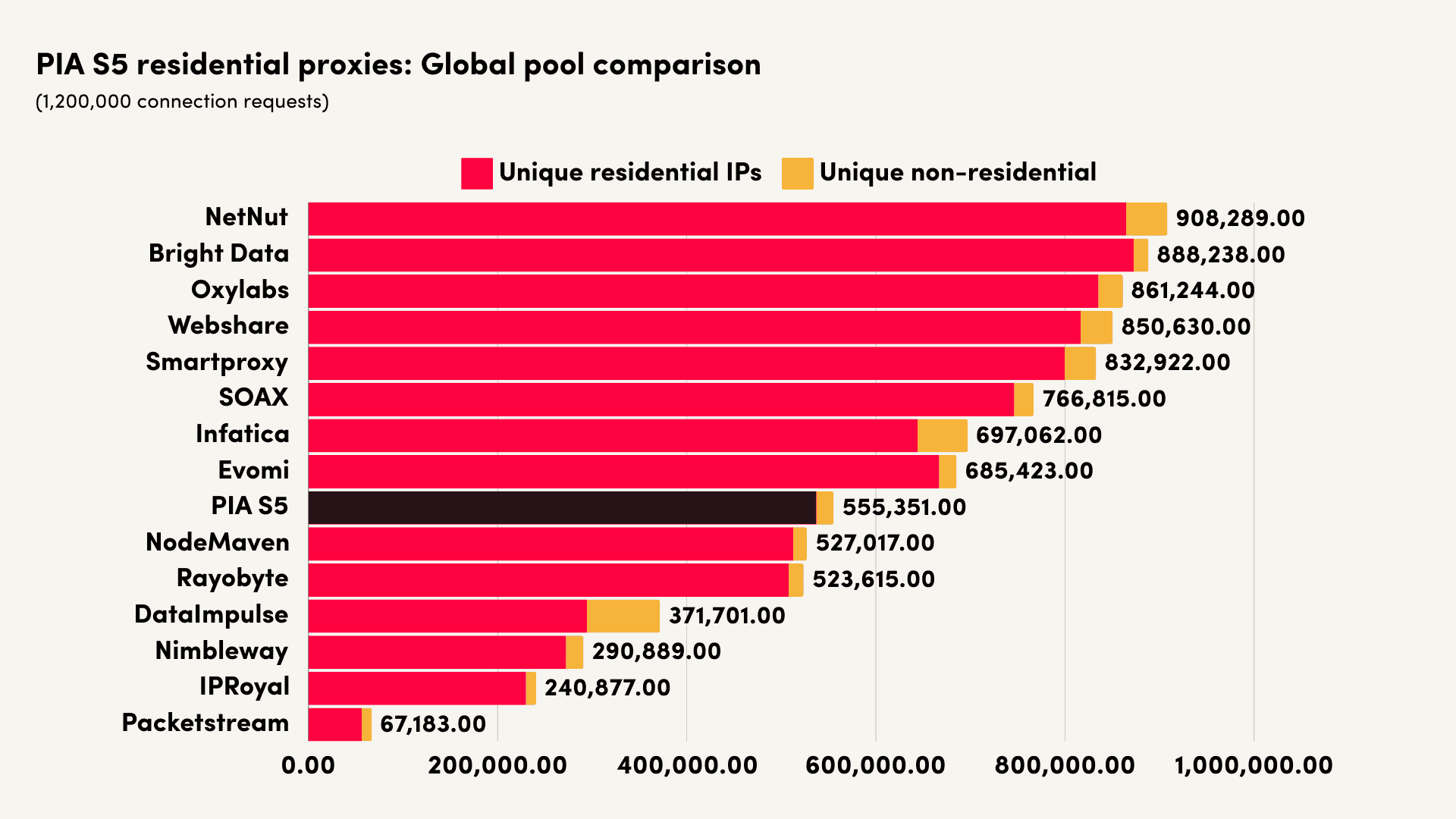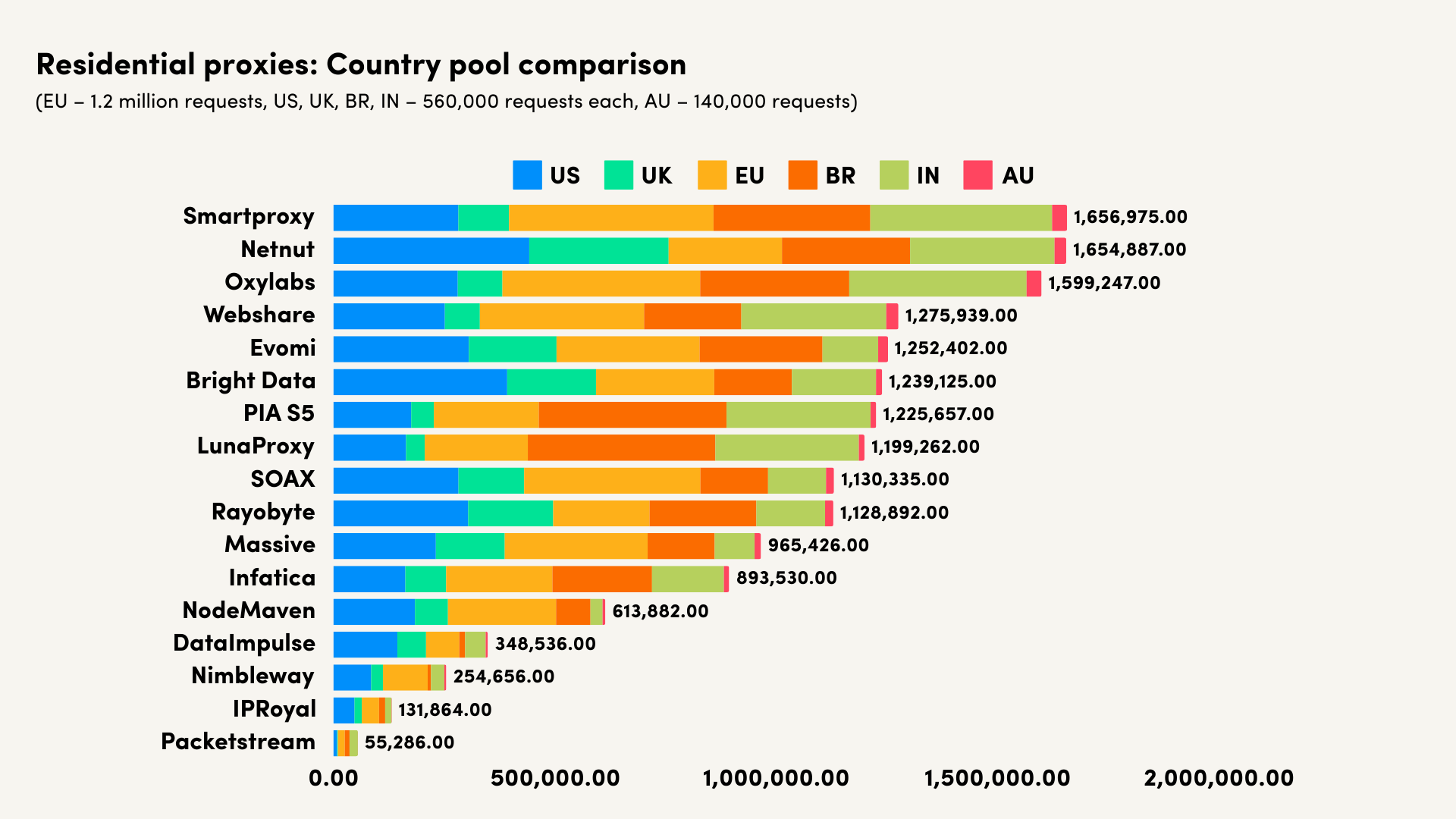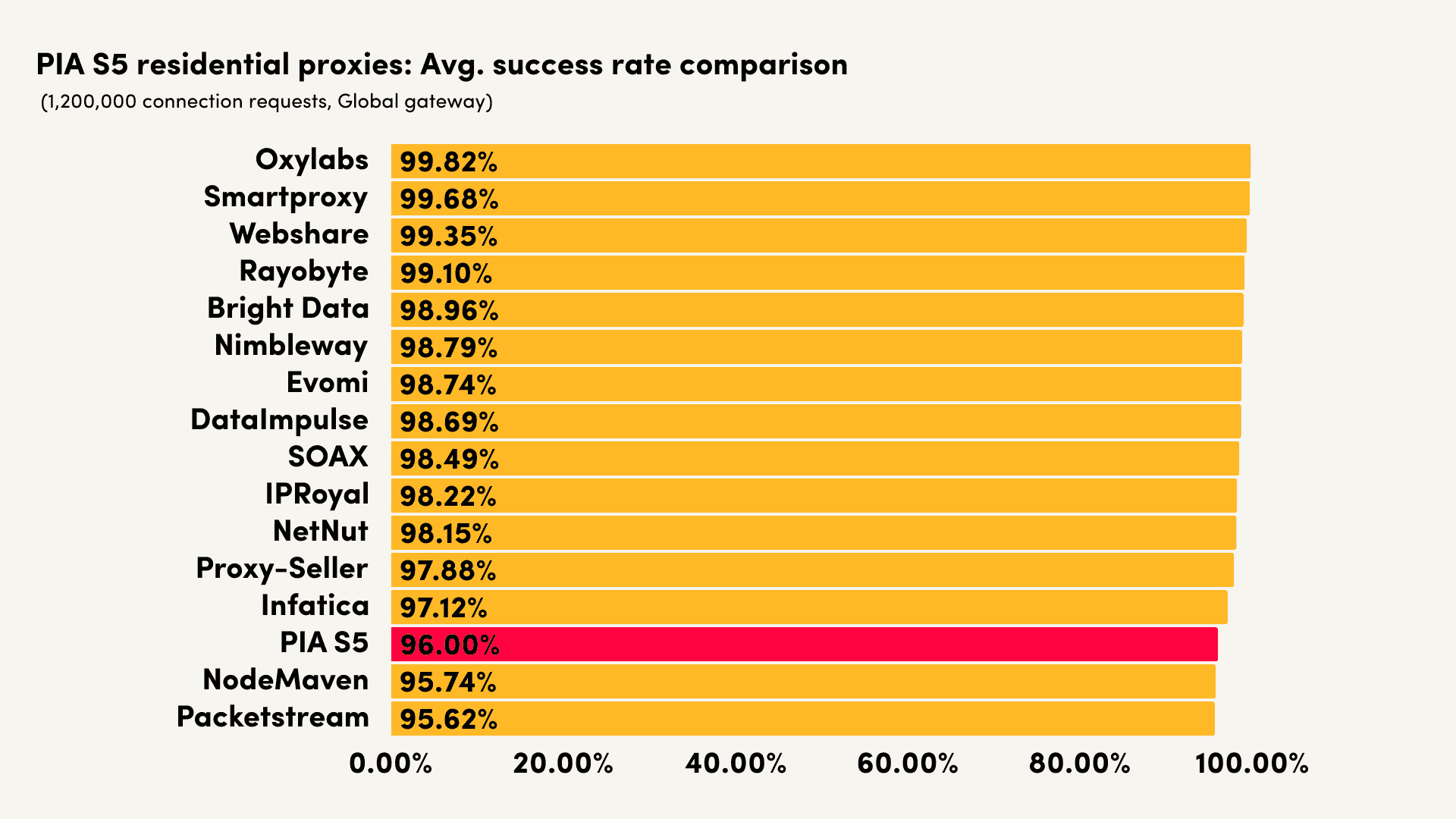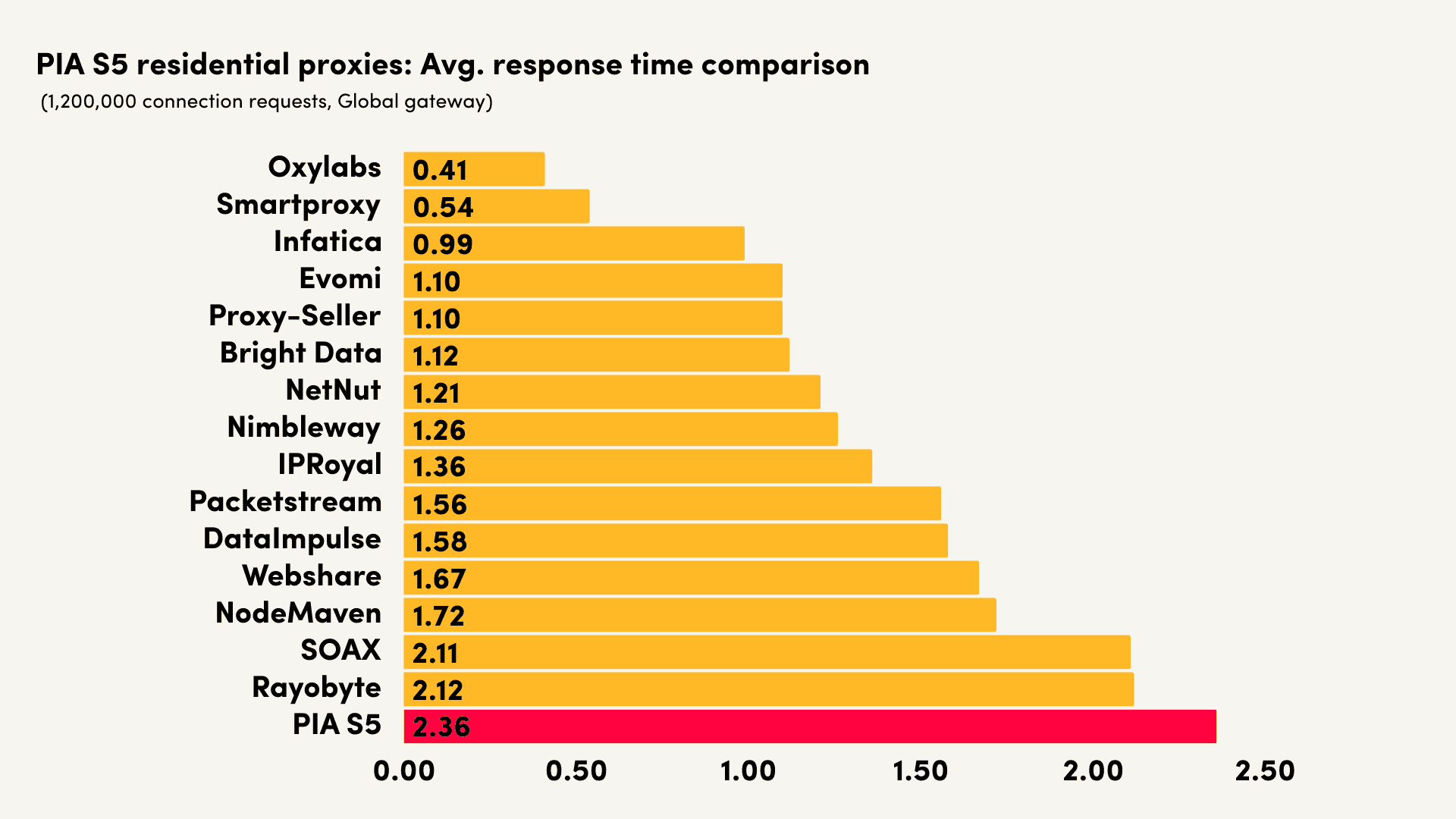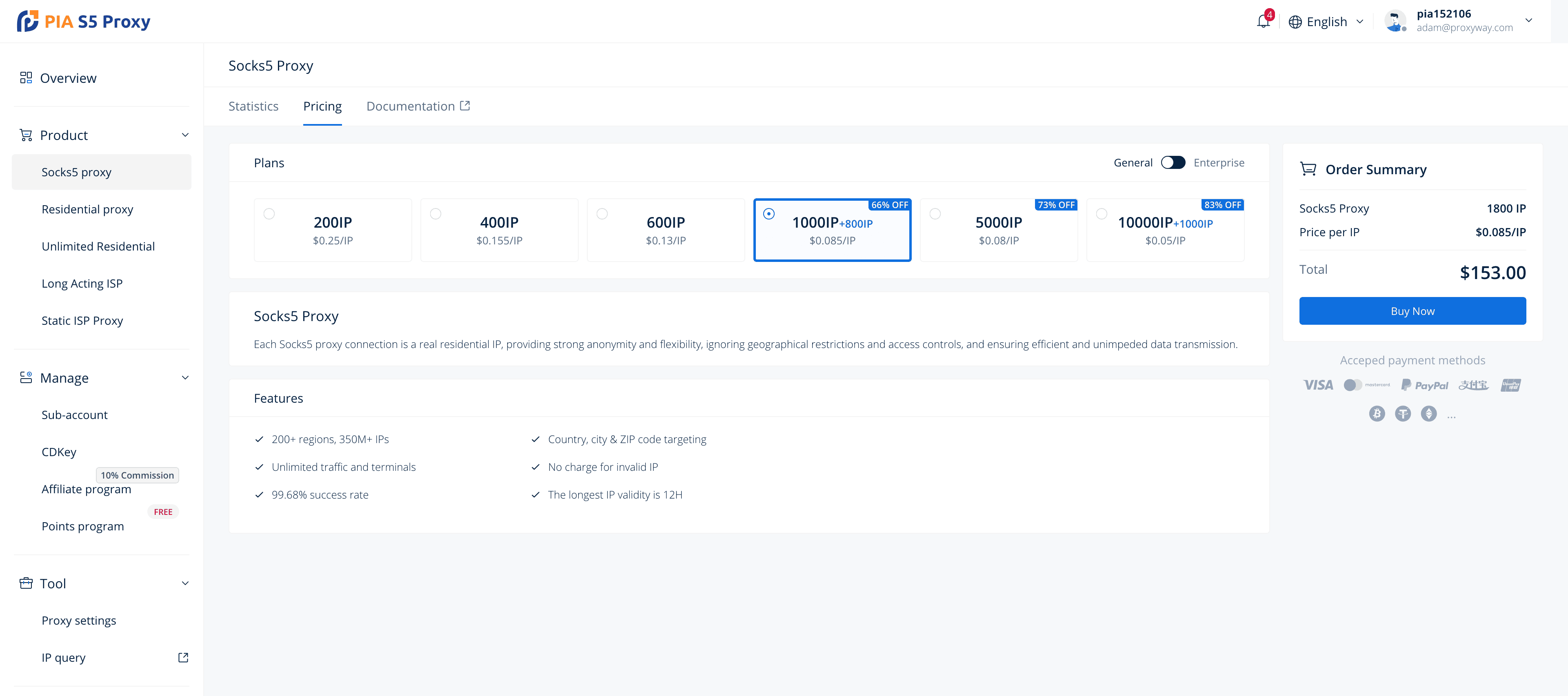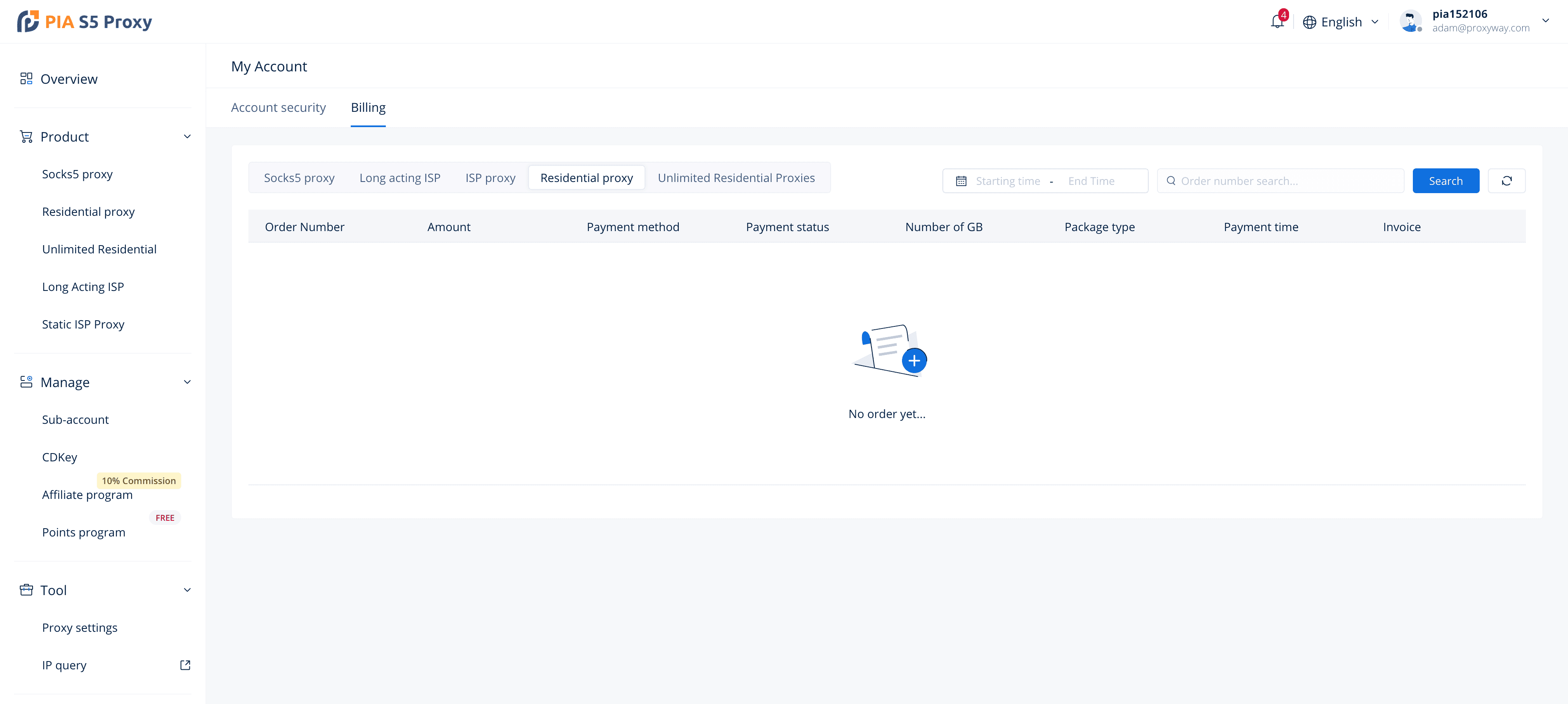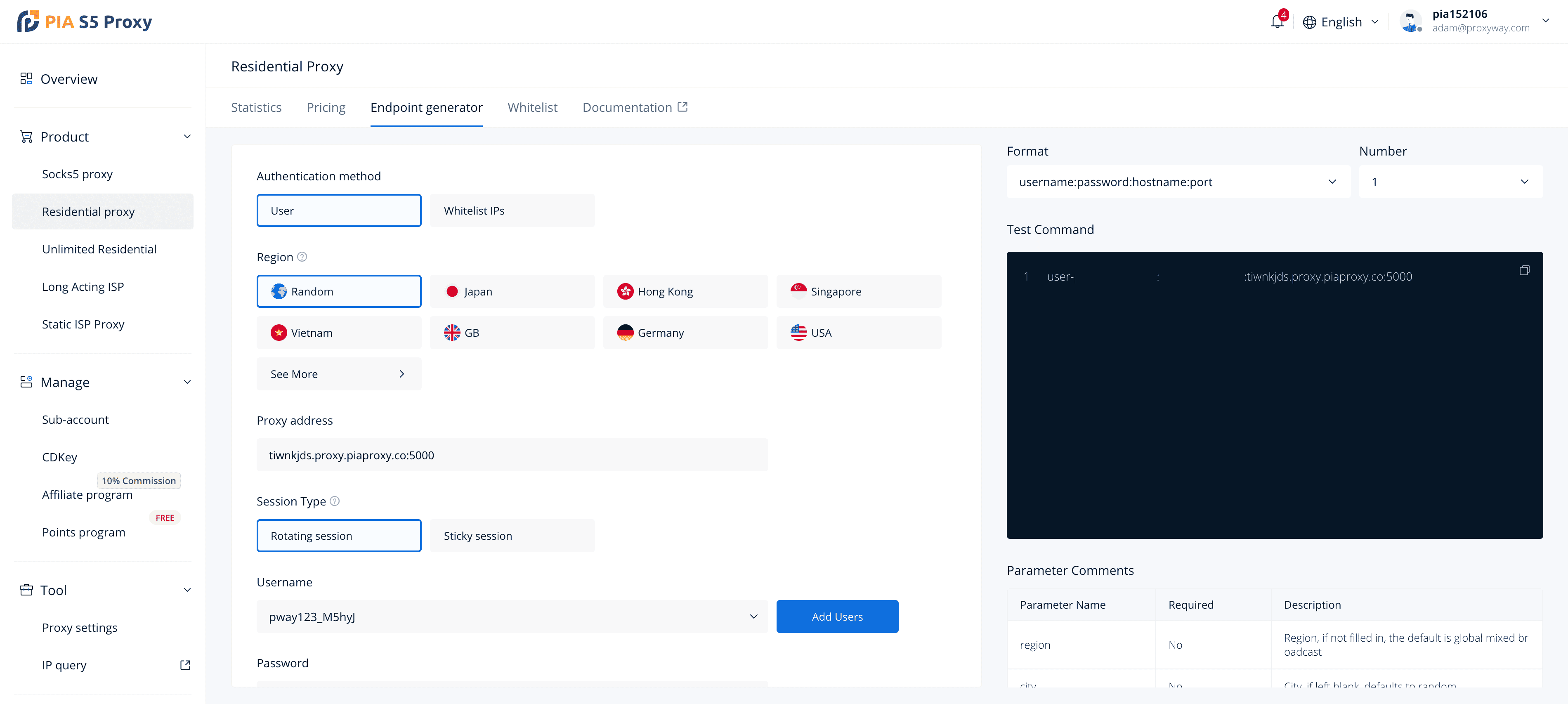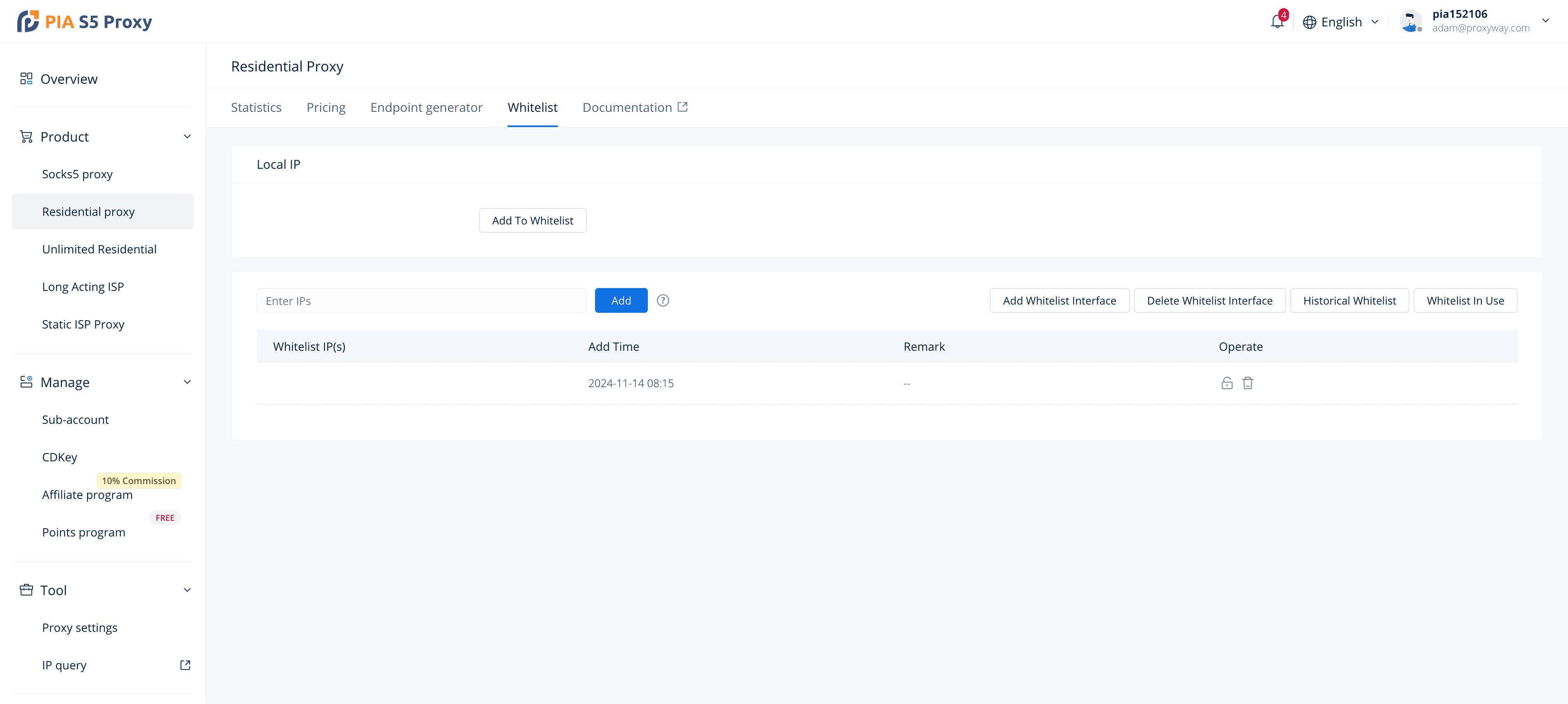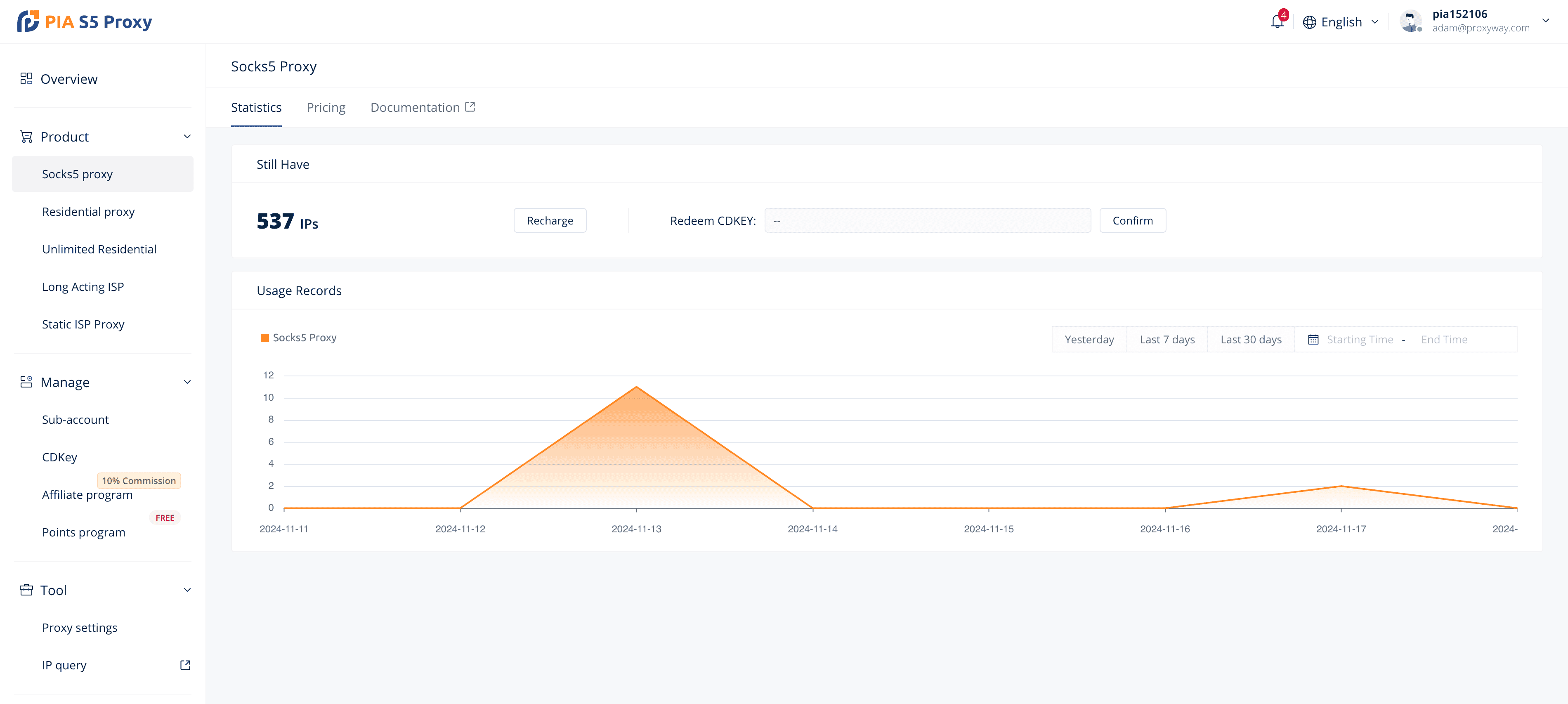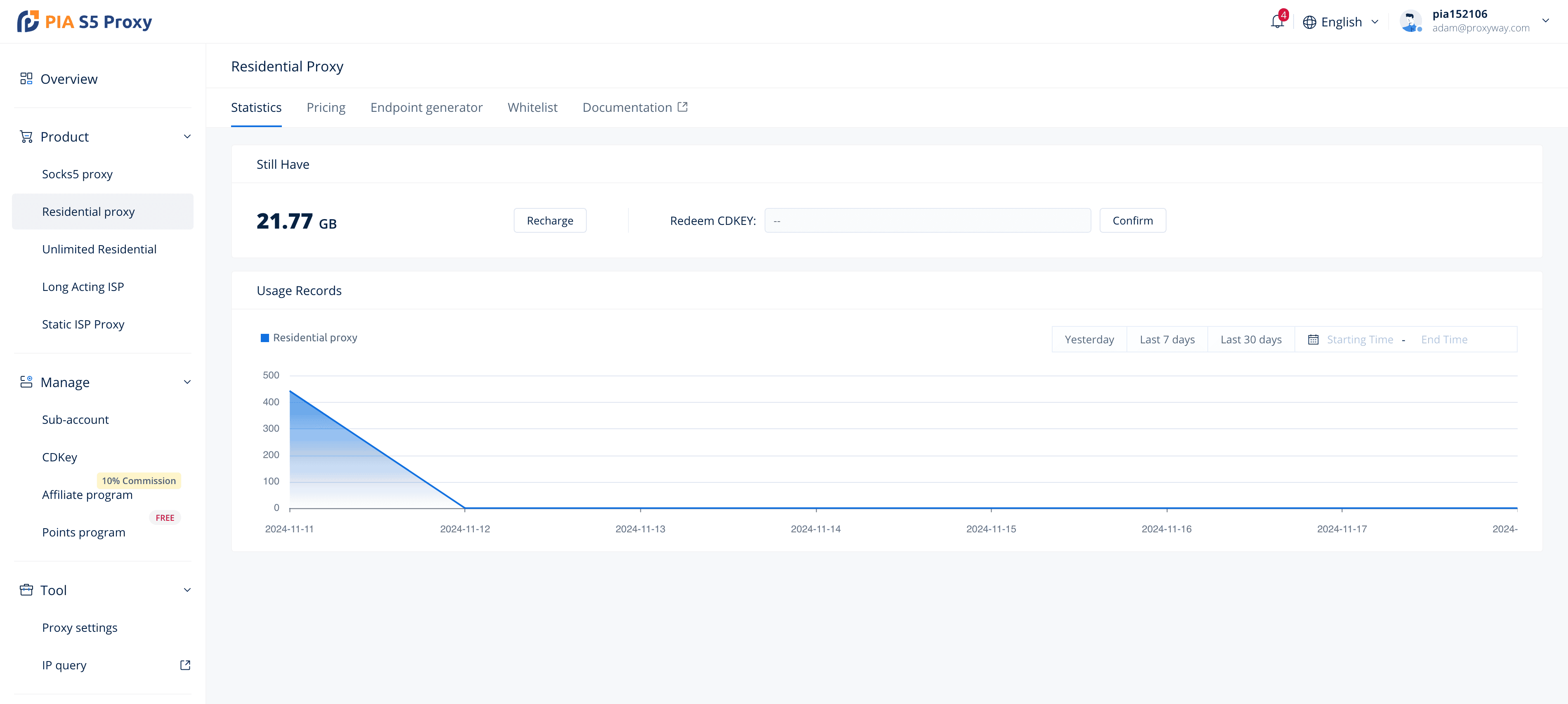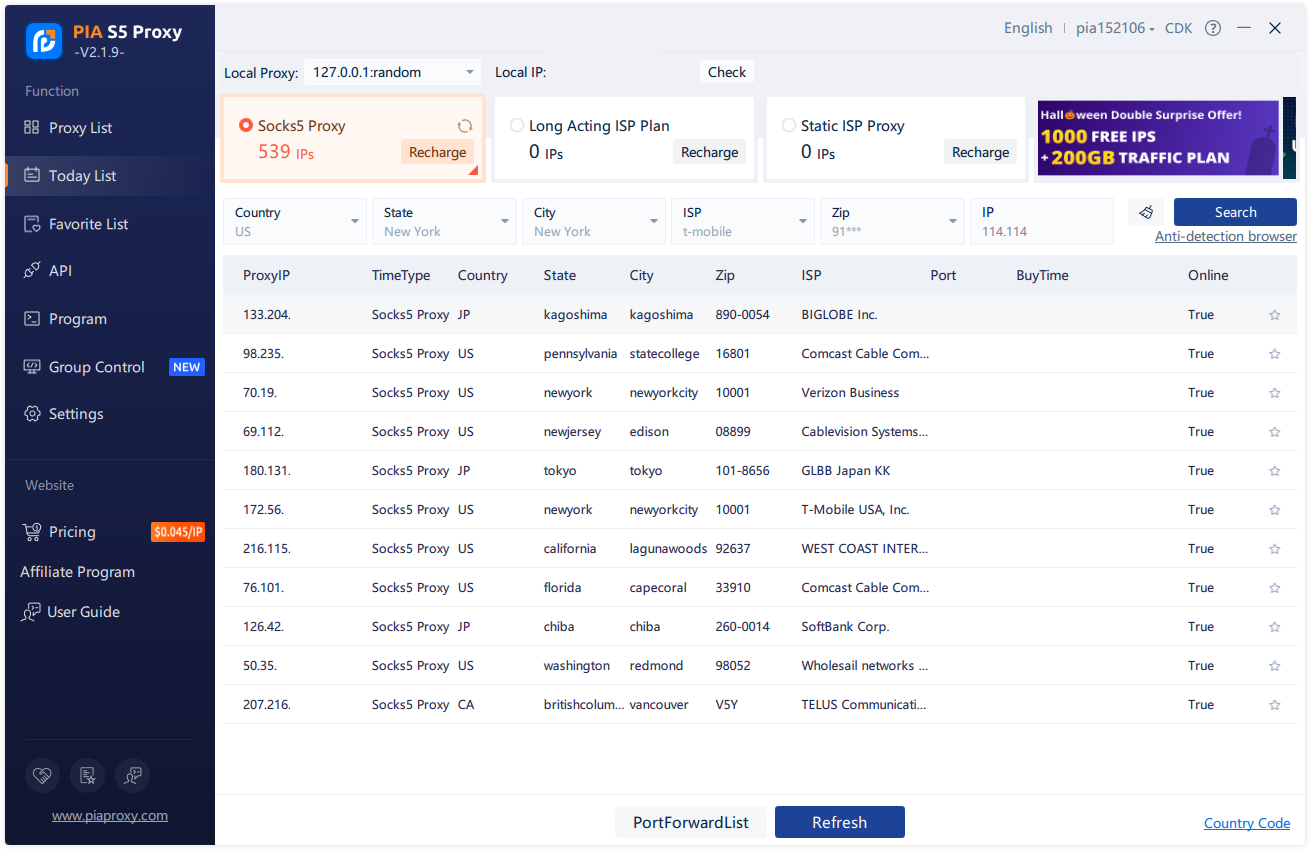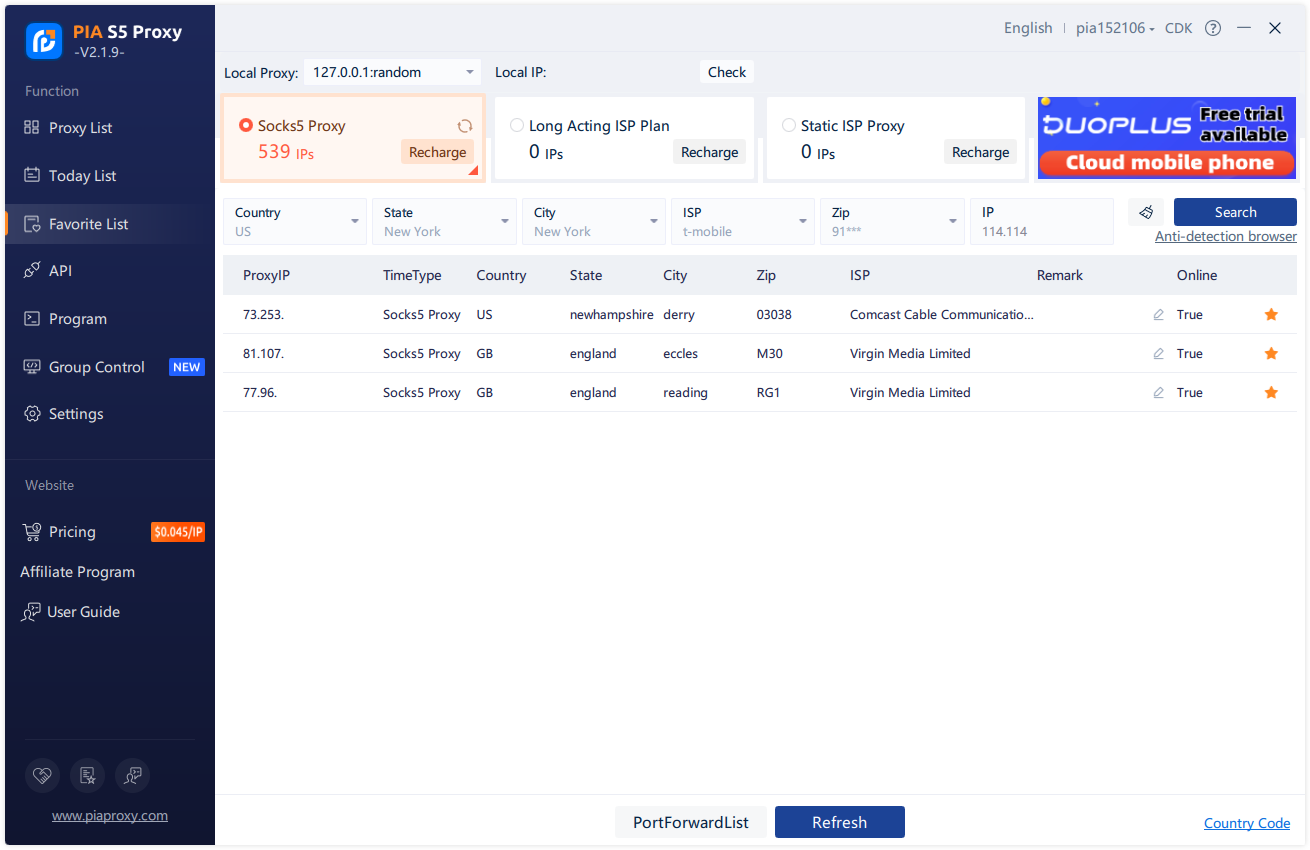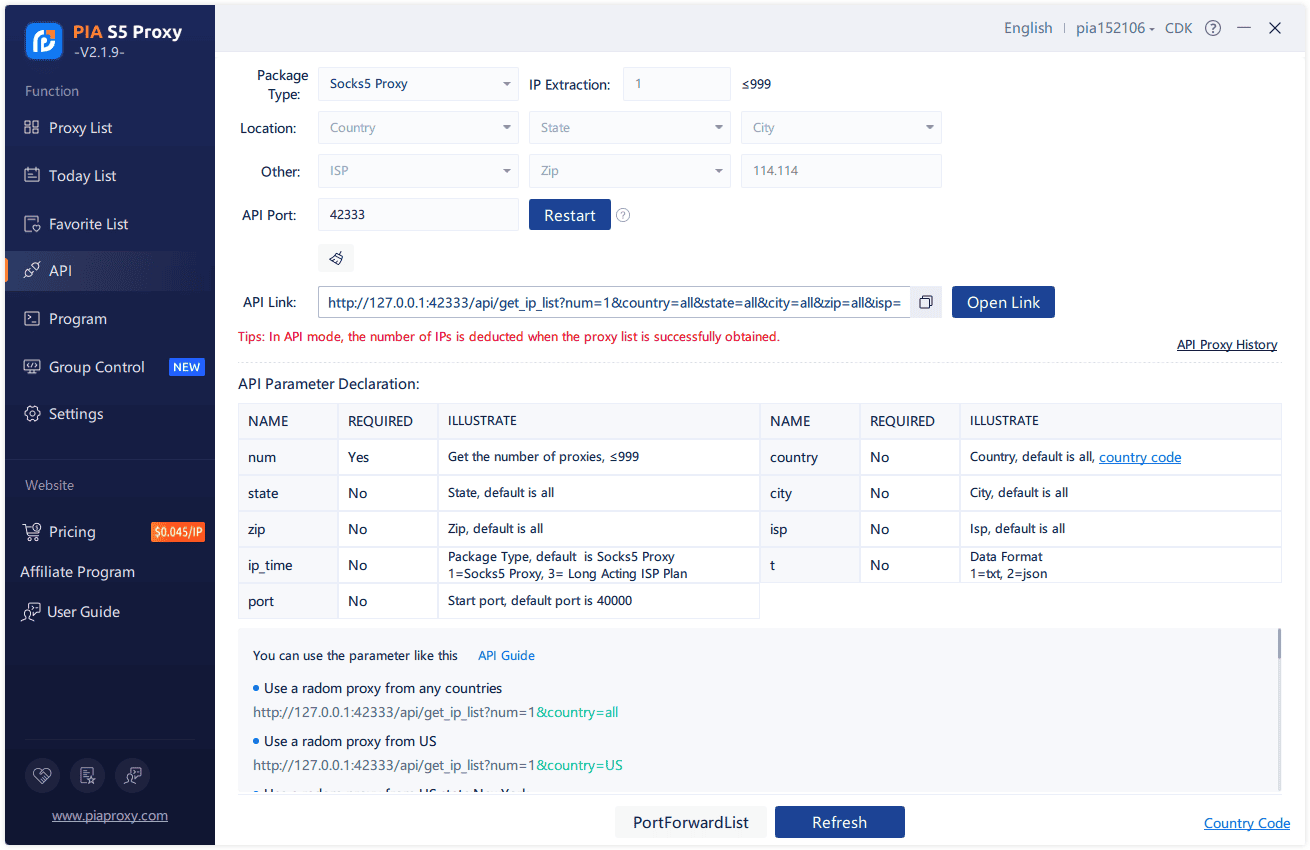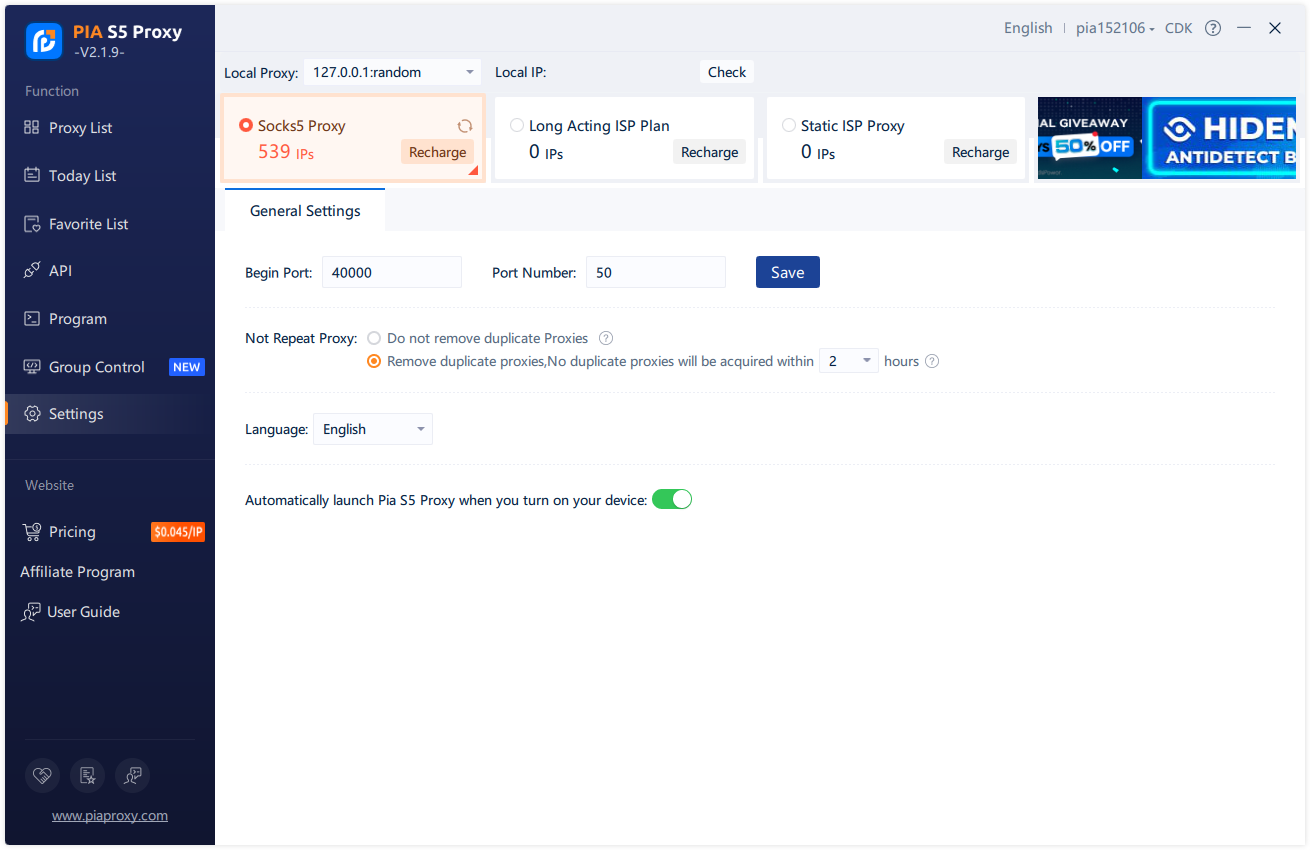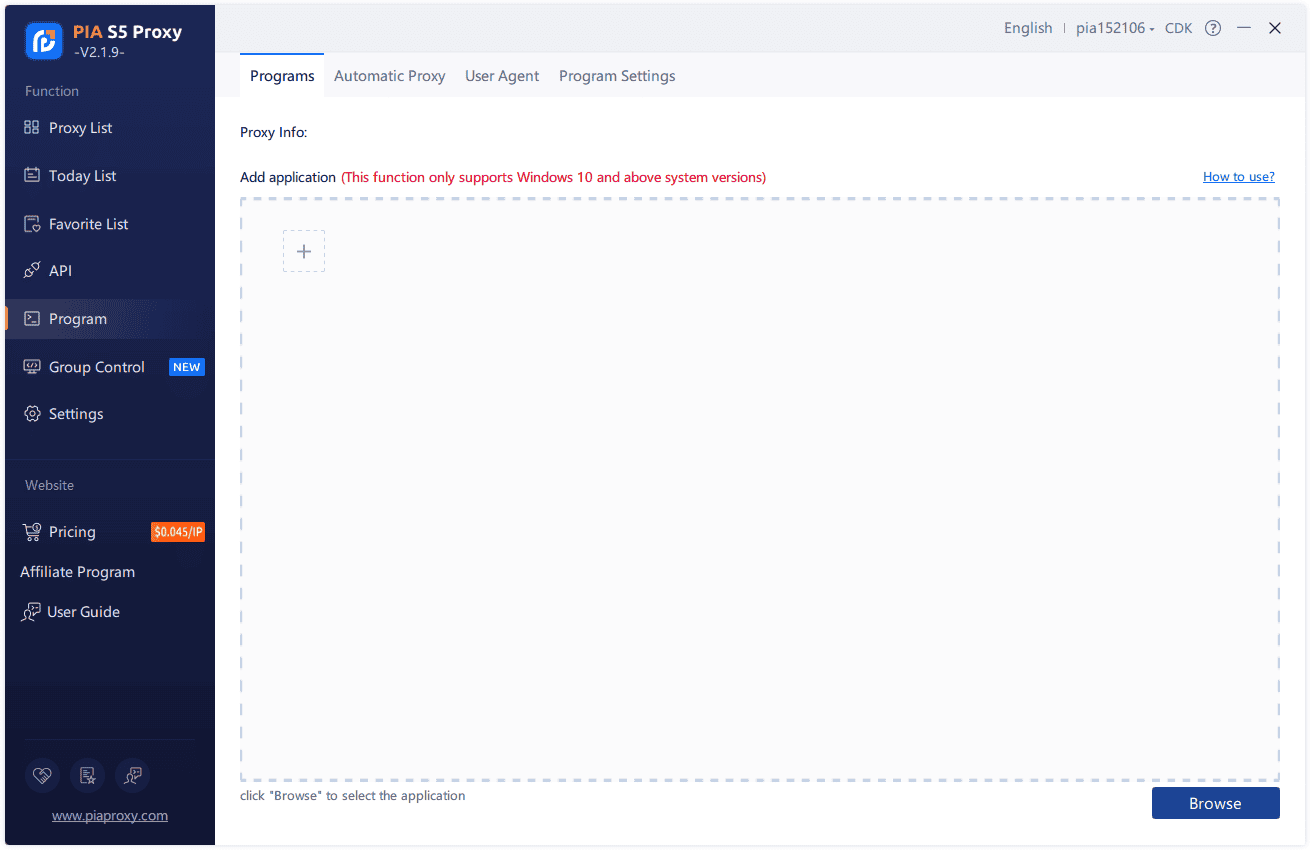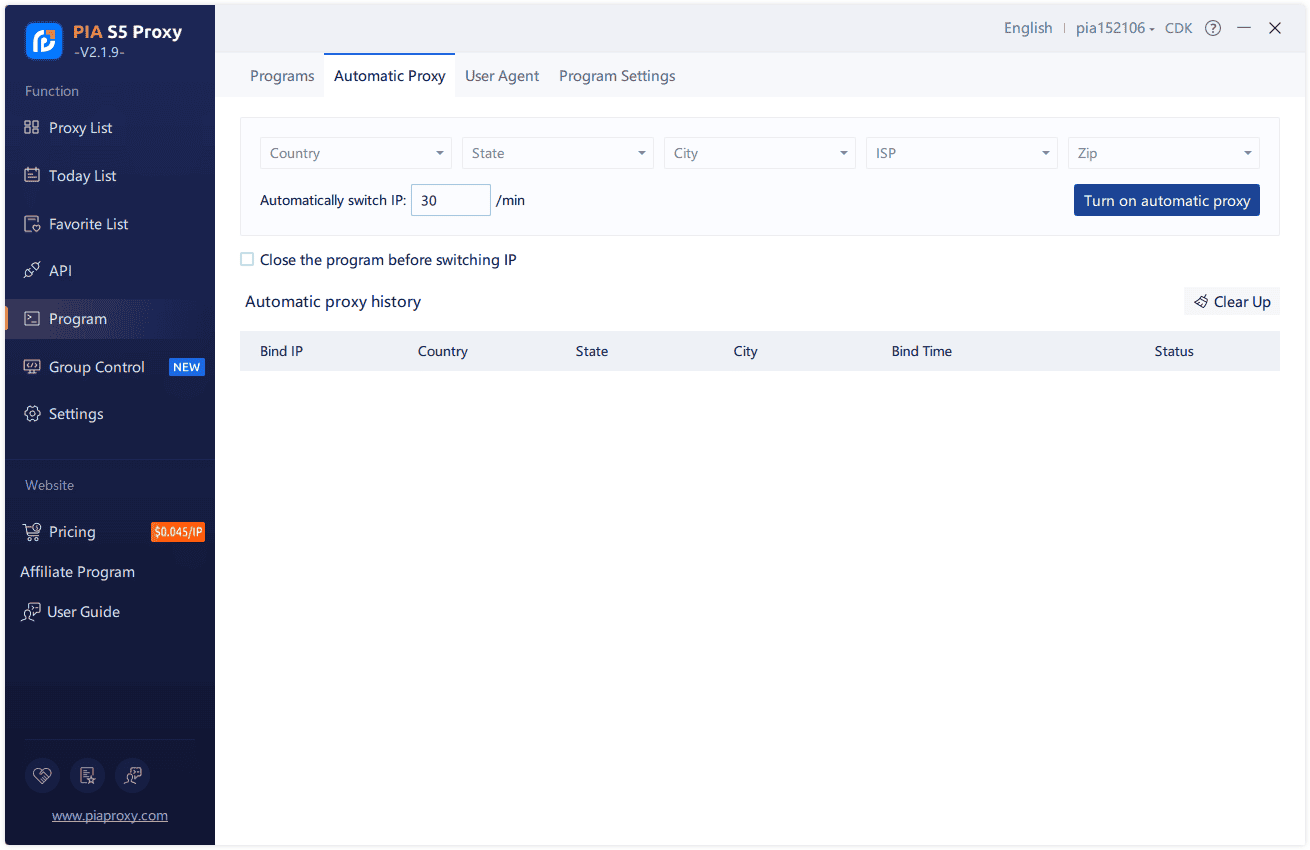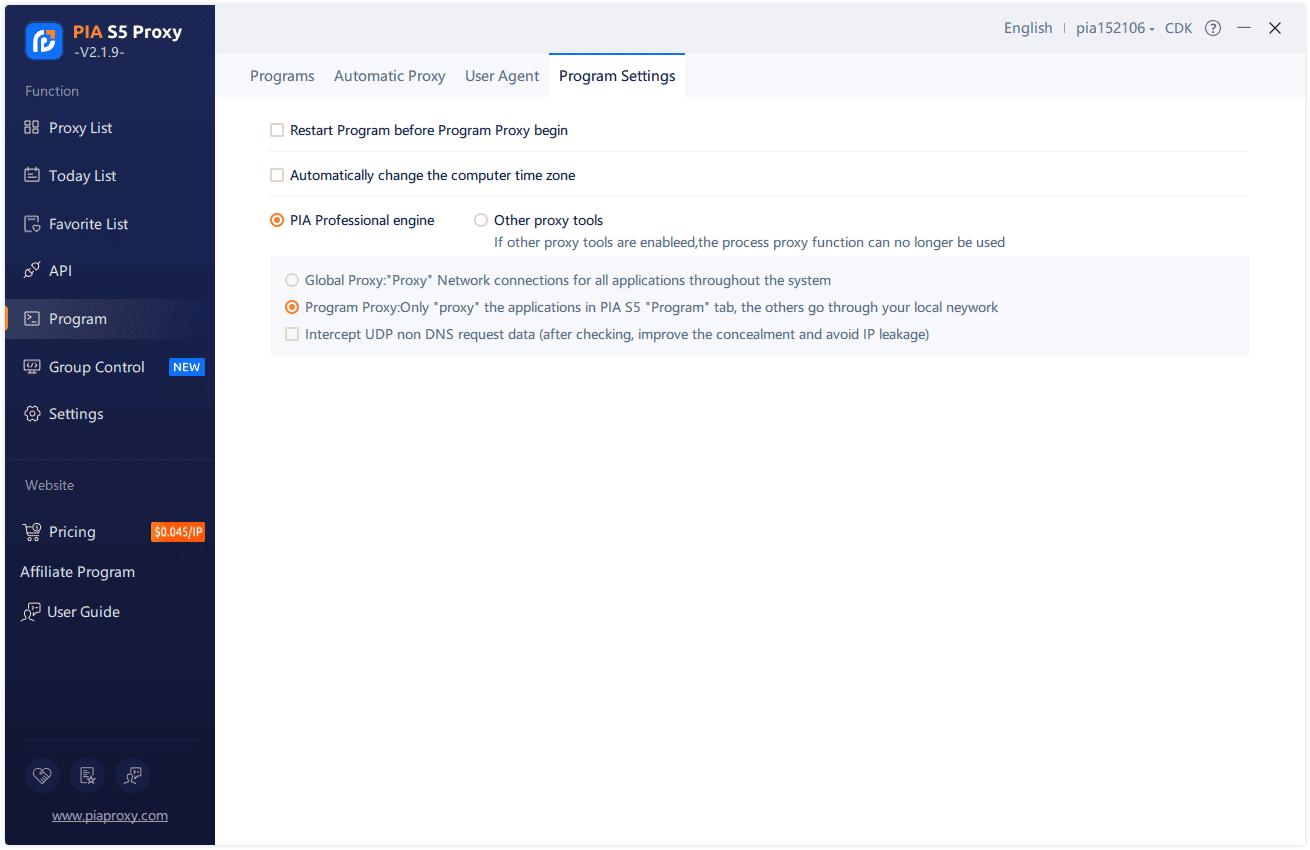PIA S5 Proxy Review
PIA S5’s proxies work decently well – and for a great price. But the provider’s user experience and policies leave things to be desired.
Use the code x to get y discount.
You’re probably considering PIA S5 for one of several reasons: you may be looking for cheaper access to residential proxies for web scraping; or you need something that could replace 911 S5. The question is – can PIA S5 deliver? And how does it compare to the competition? Well, that’s what we’re here to find out.
In this review, we’ll be testing PIA S5’s residential traffic plan and its pay-per-IP SOCKS5 proxies. Let’s go!
General Information
- Country: China (Hong Kong)
- Founded: 2022
- Proxy networks: ISP (dedicated), Residential (/IP, /GB, unlimited)
- Web scrapers: –
- Supporting tools: PIA Proxy Manager (desktop & mobile)
- Price segment: Cheap
- Starting price: $3
- Payment methods: Credit card, PayPal, AliPay, cryptocurrencies, Google Pay, Apple Pay, PTX, Giropay, more
- Trial: ❌
PIA S5 comes from the same crop of Hong Kong-located proxy providers that appeared between 2022 and 2023. Like most of them, it tries to emulate the hugely popular 911 S5, which was shut down by American authorities due to misuse.
That was at the start, anyway. By now, PIA S5 has expanded its range of services with more products, mostly related to residential proxies. They’re cheap by western standards and also scale well, giving even premium competitors like Bright Data a run for their money.
Little is known about PIA S5 as a company. Sure, its address is public, but the people aren’t. A closer inspection reveals links to several other providers which we were asked not to mention, suggesting that they may form a bigger conglomerate.
Like many proxy sellers today, PIA S5 talks about ethics. But other than one paragraph on the home page, there’s little information about how exactly PIA S5 acquires proxies or prevents network abuse. We couldn’t find a list of blocked domains, and we’re not even sure if there’s a KYC process to screen malicious customers.
So, for now at least, we could best describe PIA S5 as aggressively pragmatic. It feels like its main concern is to make money by providing good prices and little friction – everything else comes second.
News about PIA S5 Proxy
-
By Adam Dubois
- Provider News
PIA S5 Proxy Networks
PIA S5 offers access to two proxy types: residential and ISP (static residential). Each comes in two further variations: with or without PIA’s installable proxy manager application.
With the proxy manager:
- SOCKS5 residential – a big list of home IPs. You use precise filters to pick an IP, connect directly to a device, and borrow its connection until the source goes offline (max 12 hours). This consumes a credit.
- Long-acting ISP – a big list of IPs that come from servers but are linked to consumer internet service providers. They work in the same way, ensuring (a more stable) access for up to 24 hours.
Without the proxy manager:
- Residential /GB – a typical residential proxy network that connects you to a gateway server with millions of devices behind it and charges for traffic.
- Residential (unlimited) – a very similar service, only without any traffic limits.
- Static ISP – dedicated IPs that you can use for a year.
For this review, we tested PIA S5’s residential /GB and SOCKS5 residential proxy networks. We cover them below:
IP-based residential proxies (called SOCKS5 residential) are PIA S5’s main product. They were built for tasks that require fewer IPs with precise targeting (up to the street level). You interact with these proxies through PIA S5’s proxy manager app.
We’ll discuss the app more in the section on user experience, but here’s a preview of what it looks like:
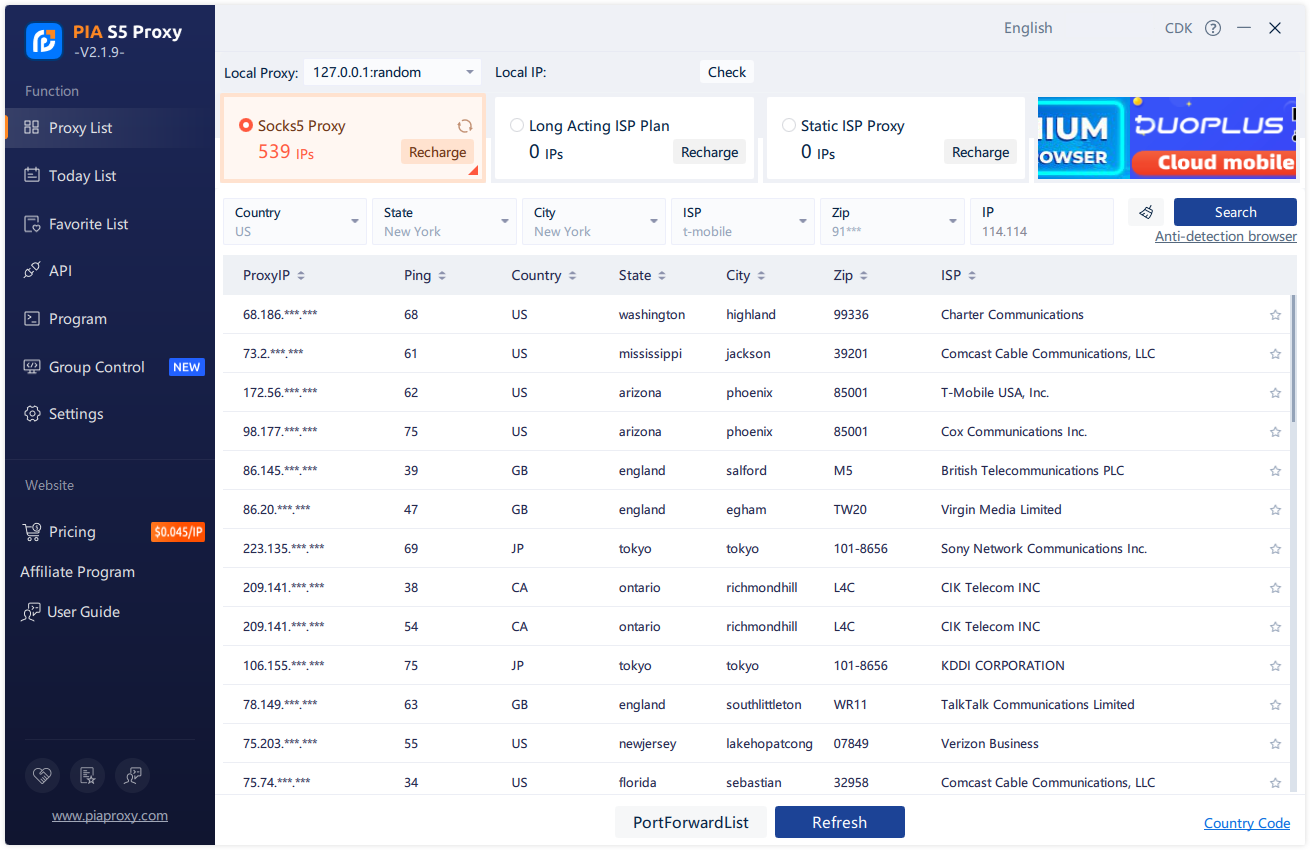
Specifications
- Advertised pool size: 350 million
- Locations: ~200 countries
- Targeting options: Global, country, state, city, ASN, ZIP code
- Rotation: ❌
- Traffic: Unlimited
- Concurrency: Unlimited ports
- Protocols: HTTP(S) over SOCKS5
As with its /GB based pool, PIA S5 advertises to control a huge number of IPs. The claim is of course exaggerated, but you’ll find plenty of proxies in most locations. Just don’t expect to get hundreds of IPs every time once you narrow it down to a city and ISP level. One exception is China, where the options are extremely limited.
These proxies don’t rotate by default, but they’re not meant to – the aim is to keep the same IP for as long as possible, even when it goes offline. There are no traffic limits, but you shouldn’t be pushing too much traffic through one device.
Integration & Use
- Connection method: Gateway address
- Connection format: 127.0.0.1:40000, 127.0.0.1:40001…
- Protocols: HTTP(S) over SOCKS5
- Authentication: Not needed
To integrate this product, you go to PIA S5’s proxy manager and filter the provided list of IPs. The app then creates a local gateway server, where you bind proxies to different ports: 40000, 40001, and so on.
There’s no need for a username and password or IP whitelisting, as access is bound to the device that runs PIA S5’s proxy manager. As such, these proxies are best suited for use on a local device.
Pricing Plans
- Model: One-time purchase
- Format: Pay per IP
- Modifiers: ❌
- Starting price: $50 for 200 IPs ($0.25/IP)
- Trial: ❌
You use the /IP residential proxies by buying credits. A credit gives you access to one proxy for 12 hours, even when it goes offline. There’s no expiration period for unused credits, so it’s a good idea to get some during promotions.
PIA S5 offers various packages that range from 200 IP credits (at $0.25/IP) to 40,000 or more (at $0.045/IP). The cheapest package costs $50, which is pretty steep these days. It’s hard to compare the rates with other providers, as not many competitors use this format.
Performance Benchmarks
We last tested PIA S5’s residential proxies in November 2024.
The provider emphasizes uptime and download speed as two important metrics, so that’s exactly what we tested.
#1: Download speed
- Proxies tested: 10 in the US
- Target: Hetzner’s 100 MB Ashburn speed test
| Avg. without proxies | Avg. download speed | Slowest IP |
| 21.38 MB/s | 2.15 MB/s | 0.15 MB/s |
PIA S5 claims that the throughput of its proxies reaches 20-50 M/s (MB or Mb? Not sure), but we couldn’t verify this. Their speed was typical of residential proxy servers – in other words, not very fast.
#2: Proxy uptime
- Proxies tested: 20 in random locations
- Duration: 12 hours at 1 req/min
| Avg. uptime | Median | Longest | Shortest |
| 4 h 39 min | 5 h 54 min | 5 h 55 min | 23 min |
On the other hand, our randomly selected proxies stayed online much longer than a typical residential device – and much more consistently. Though the sample size is small, the results are promising.
PIA S5 introduced traffic-based residential proxies in 2024, or two years after launch. This service is best suited for web scraping and similar tasks, when you need access to a large number of IPs.
Specifications
- Advertised pool size: 350 million
- Locations: ~80
- Targeting options: Global, country, state, city
- Rotation: Every request, 1-90 minutes
- Traffic: Plan based
- Concurrency: Unlimited threads & ports
- Protocols: HTTP(S) over SOCKS5
PIA S5 advertises 350 million IPs, which is a massive amount. But these numbers rarely mean much – and as we’ll see, aren’t exactly truthful.
t’s interesting that PIA S5’s proxy setup widget only shows around 80 locations. For example, just six African countries are available. This is way fewer compared to most competitors. You can filter IPs up to the city level. For more accurate targeting, you’ll need to use the other, /IP residential network.
PIA S5’s traffic-based residential proxies rotate. The default is every connection request, and you can establish sticky sessions that can last up to 90 minutes. In reality, their duration will depend on the end user supplying the IP.
The dashboard widget provides no option to select a connection protocol, so we assume that all requests go through a SOCKS5 tunnel using TCP. There are no limits on how many parallel requests you can make at once.
Integration & Use
- Connection method: Gateway address
- Authentication: Credentials, IP whitelisting
- Connection format: USERNAME-region-us-city-newyork-sessid-ID-sesstime-TIME:[email protected]:5000
PIA S5 connects you to a backconnect gateway server, which then sends the request through a real user’s device. The provider has several such servers, depending on the proxy location. For example, targeting the US will slightly change the server’s address by adding na to it.
PIA S5’s whitelisted IP implementation uses the IP:Port format with different ports for sticky sessions. Make no mistake – you’re still connecting through gateway servers, only presented differently.
Pricing Plans
- Model: Subscription
- Format: Pay per traffic
- Modifiers: –
- Starting price: $17.5 for 5 GB ($3.5/GB)
- Trial: ❌
PIA S5 offers only subscription plans for its residential proxies. On the bright side, the entry cost is only $17.5. A plan lasts for a month.
Compared to most non-Chinese competitors, PIA S5’s residential proxies are very cheap. They scale especially aggressively betwen 5 and 100 GB of traffic. The provider also constantly runs various promotions, allowing new customers to snag its residential proxies even cheaper.
Performance Benchmarks
We last tested PIA S5’s residential proxies in November 2024.
#1: Pool size & composition
| Gateway | Parameters | Unique IPs | Residential %* |
| Global | 1.2M req, 21 days | 555,352 | 95.52% |
| US | 560k req, 14 days | 175,406 | 93.64% |
| UK | 560k req, 14 days | 51,234 | 88.89% |
| EU** | 1.2M req, 14 days | 237,074 | 94.45% |
| Brazil | 560k req, 14 days | 423,958 | 96.09% |
| India | 560k req, 14 days | 325,430 | 96.29% |
| Australia | 140k req, 7 days | 12,555 | 92.80% |
* IP2Location database, Usage type data point (ISP, ISP/MOB, MOB IPs)
** Combines Germany, France, Spain, Italy, the Netherlands.
In our tests, PIA S5 failed to deliver on its marketing promises. While by no means small, its residential proxy pool returned fewer IPs than a half of our tested competitors.
On a more positive note, we found a huge number of proxies in India and especially Brazil. What’s more, the majority were on residential connections.
One more interesting observation was how balanced the Global pool was. The 555k unique IPs we found came from 200 locations, and not a single one had more than 7,000 IPs in it. PIA S5 took great pains to ensure equal distribution.
#2: Infrastructure Performance
Parameters: Same as the pool test
Target: Nearest server of a global CDN (<10 KB page size)
| Gateway | Our server location | Avg. success rate | Avg. response time |
| Global | Germany | 96.00% | 2.36 s |
| US | US | 98.43% | 0.97 s |
| UK | Germany | 99.00% | 0.76 s |
| EU | Germany | 98.38% | 0.97 s |
| Brazil | US | 98.78% | 1.53 s |
| India | Singapore | 97.43% | 1.13 s |
| Australia | Singapore | 97.04% | 1.84 s |
PIA S5 also didn’t blow us away with its infrastructure performance. Both the success rate and response time were among the last in our comparison.
Having said that, the residential proxies had a strong performance in individual locations, namely the US and UK. Still, there’s much room for improvement.
How to Use PIA S5 Proxy
Registration
To create an account, not much info is needed: only an email address. You can also register using Apple and Google accounts.
It doesn’t seem like there’s a KYC process. And while it was recommended, we didn’t even have to verify our email.
Dashboard
PIA S5 has a dashboard for interacting with its services. The dashboard includes most of the usual features: you can buy a plan, download invoices, set up proxies, track their use, and get PIA S5’s proxy management software. However, we didn’t find a way to easily contact support.
The dashboard is available in nine languages, including Russian, Spanish, Portuguese, Chinese (naturally), and more.
Each product has its own tab, where you’ll be doing most of the interactions. The dashboard’s main page tries both to sell and show quick usage statistics. However, we found some information surprisingly hard to find, such as how long our subscription will last.
This is partly because PIA S5 created the dashboard around its SOCKS5 residential product (which never expires) and then added everything else on top. But this doesn’t get in the way too much.
What did get in our way was that the dashboard simply doesn’t fit into a laptop screen. A more responsive design would be welcome.
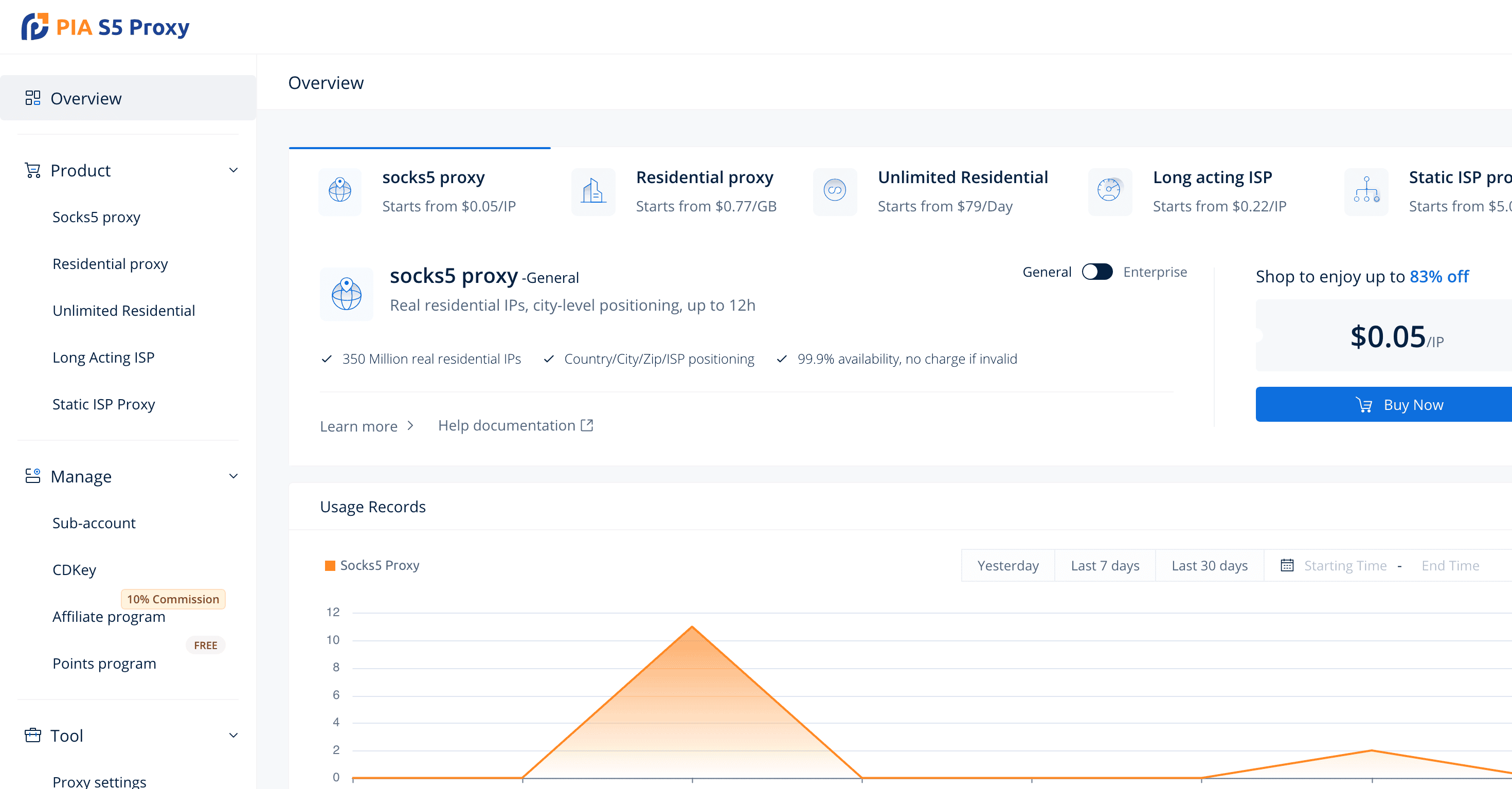
PIA S5 has no wallet, so each subscription or top-up will require a separate payment. The dashboard provides no way to enter you payment details, so you’ll have to do it during purchase. The provider offers multiple payment gateways, including AliPay, PayPal, and cryptocurrency.
Once you buy a plan, PIA S5 generates an invoice. The Billing page shows additional information about the transaction, including its date, units bought, and the payment method which you used.
The dashboard provides proxy management tools for some of the products: namely, traffic-based, unlimited residential proxies, and dedicated datacenter proxies. The other two are controlled using the proxy manager application (we discuss it below).
In the case of traffic-based residential proxies, you get a standard widget. It lets you choose a location, rotation settings, then generates a cURL example with a list of gateway servers. The implementation isn’t the most elegant, but it works.
PIA S5’s usage statistics are basic. The SOCKS5 residential proxies and Long-acting ISP proxies only show how many IP credits are still available and when they were used.
The /GB residential proxies display traffic expenditure for the last day, week, month, or a custom period. You won’t see how many requests you’ve made, to which domains, or how many succeeded.
There is no network status page for checking if the service is functioning properly.
PIA S5 Proxy Manager
The proxy manager is an app for Windows, macOS, and Debian-based Linux systems. Its main purpose is to help you use PIA’s SOCKS5 residential proxies, though it also supports the long-acting and dedicated ISP products.
In brief, PIA’s proxy manager provider an interface for filtering available proxies by location, ISP, and ping. You can then bind them to a port and integrate the proxies with other apps. If you had the chance to use 911 S5, you’ll feel right at home.
The proxy manager includes various features to simplify your work. You can see the temporary IPs you selected for that day, and there’s a list of favorites which remains until removed manually.
It’s possible to integrate the proxies with various programs (for example, Chrome) directly through the manager, or you can configure it to proxy all traffic. Enterprise users get the option to share access with their teammates through what PIA S5 calls CDKEY functionality.
Mobile Apps
PIA S5 also offers Android and iOS apps for using its proxies on a smartphone. They work similarly to a VPN – the difference is that you get a residential IPs address.
API Access
An API is available for PIA S5’s proxy manager application. It allows generating new proxies from the list of available IPs based on their location parameters.
Documentation
PIA S5’s documentation hub includes a lot of content, but its quality and structure are rather poor.
The articles mostly cover the SOCKS5 residential product; even then, the information is scattered throughout several sections and mixed with other services. There are plenty of integration articles for antidetect browsers but barely any for web scraping libraries – another area for improvement.
Overall, documentation isn’t PIA S5’s strong suit.
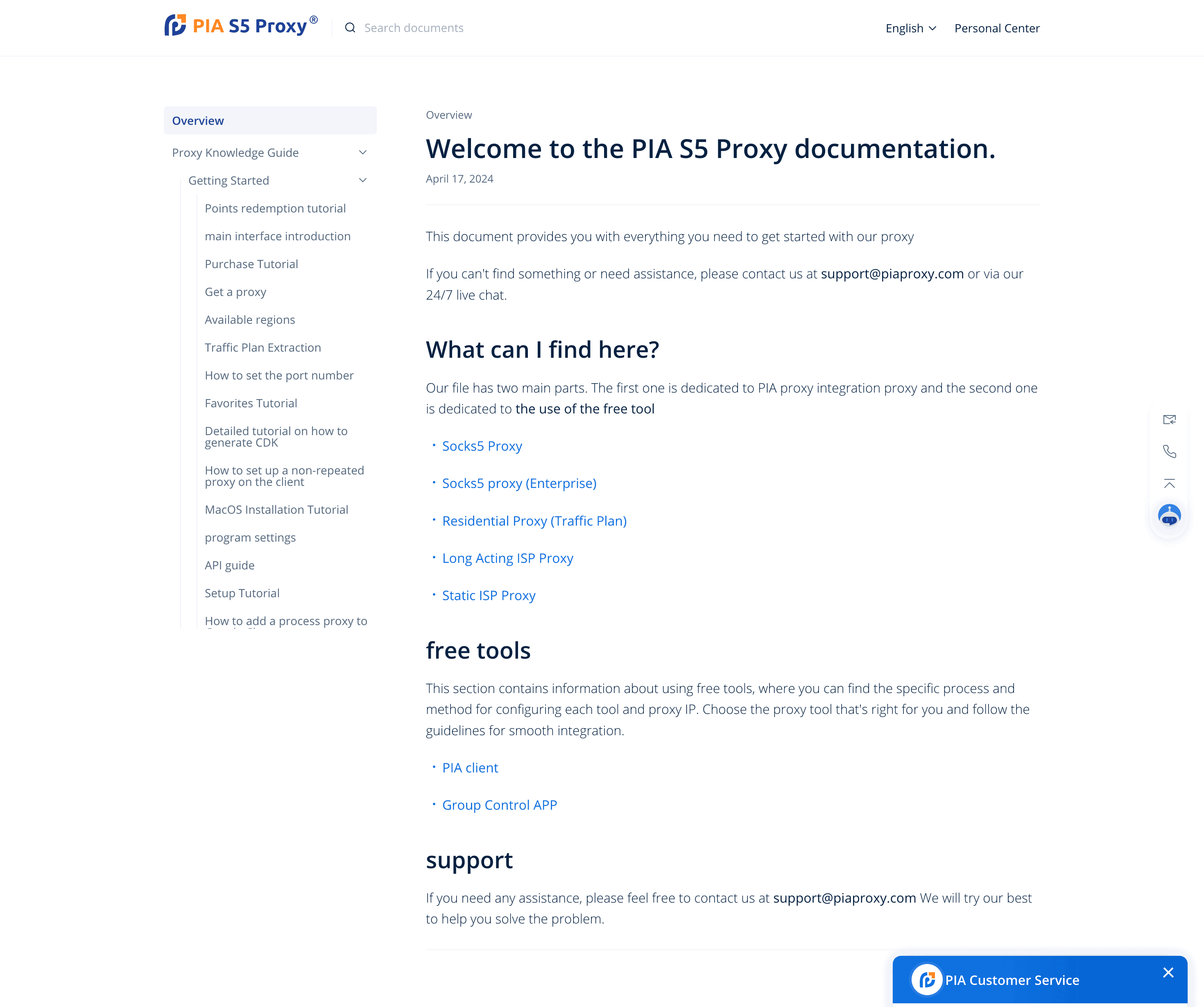
Hands-On Support
PIA S5 has a live chat button accessible on the website. The poor chatbot there is useless for anything that steers away from the script. And if you ask for a human, it simply throws its hands up, stating that the question was too difficult to understand.
Thankfully, you can contact a customer support agent using the provided email address. You’ll most likely receive help. However, it will only come within 24 hours on Monday to Friday 9:00-18:00 UTC, or within 48 hours outside this timeframe. This isn’t great.
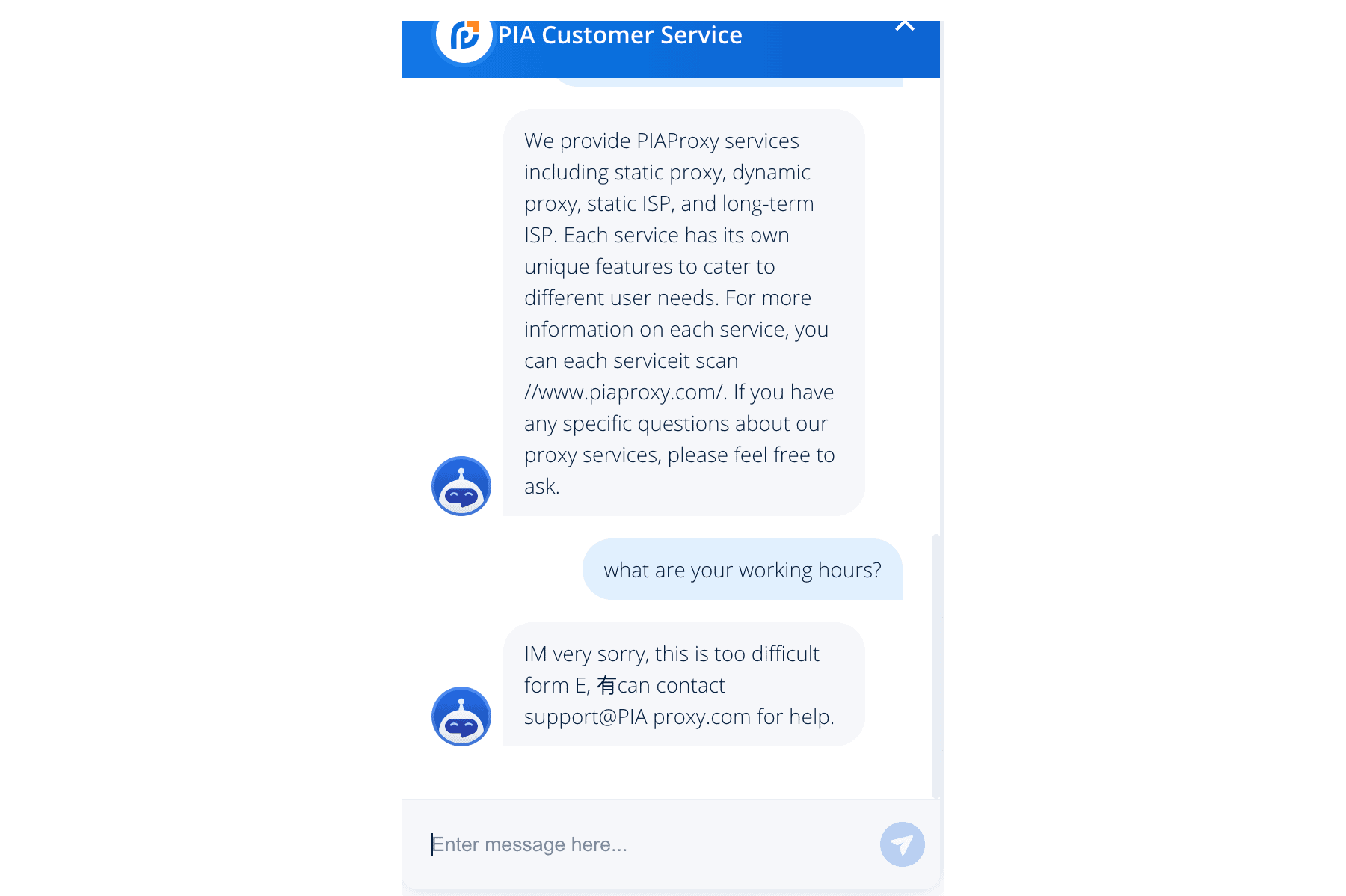
Conclusion
PIA S5 has obvious weaknesses: for us, it’s the user experience and a lack of clarity about the sourcing and usage policies of the residential proxy network. By today’s standards, the infrastructure performance is also a year or two behind industry leaders.
On the other hand, you get a decently large IP pool, especially in South America. Furthermore, PIA S5’s proxies are actually pretty solid when compared to similarly priced alternatives. And if you’re after a 911 S5 replacement, the proxy manager here is almost a carbon copy, so it shouldn’t leave you disappointed.
So in the end, it’s about needs and priorities. If yours align with what PIA S5 can offer, then this provider can be a strong choice.
PIA S5 Alternatives

Dataimpulse’s residential proxy network is smaller but also similarly cheap and never expiring.

Bright Data costs much more; for this, you get more IPs, better performance, and a proxy manager that’s even more powerful.
LunaProxy is extremely similar in most regards, but its 911 S5 application doesn’t require a separate subscription.
Recommended for:
Anyone looking to replicate the 911 S5 experience.
